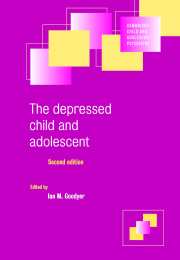Book contents
- Frontmatter
- Contents
- List of contributors
- Preface
- 1 Historical aspects of mood and its disorders in young people
- 2 The development of emotional intelligence
- 3 Developmental precursors of depression: the child and the social environment
- 4 Physiological processes and the development of childhood and adolescent depression
- 5 Childhood depression: clinical phenomenology and classification
- 6 The epidemiology of depression in children and adolescents
- 7 Family–genetic aspects of juvenile affective disorders
- 8 Life events: their nature and effects
- 9 Adolescent depression: neuroendocrine aspects
- 10 Suicidal behaviour in adolescents
- 11 Psychopharmacology of depressive states in childhood and adolescence
- 12 The psychotherapeutic management of major depressive and dysthymic disorders in childhood and adolescence: issues and prospects
- 13 Natural history of mood disorders in children and adolescents
- Index
11 - Psychopharmacology of depressive states in childhood and adolescence
Published online by Cambridge University Press: 18 December 2009
- Frontmatter
- Contents
- List of contributors
- Preface
- 1 Historical aspects of mood and its disorders in young people
- 2 The development of emotional intelligence
- 3 Developmental precursors of depression: the child and the social environment
- 4 Physiological processes and the development of childhood and adolescent depression
- 5 Childhood depression: clinical phenomenology and classification
- 6 The epidemiology of depression in children and adolescents
- 7 Family–genetic aspects of juvenile affective disorders
- 8 Life events: their nature and effects
- 9 Adolescent depression: neuroendocrine aspects
- 10 Suicidal behaviour in adolescents
- 11 Psychopharmacology of depressive states in childhood and adolescence
- 12 The psychotherapeutic management of major depressive and dysthymic disorders in childhood and adolescence: issues and prospects
- 13 Natural history of mood disorders in children and adolescents
- Index
Summary
Introduction
Over the past 50 years there has been a controversial debate concerning the issue of depression in childhood and adolescence. According to Carlson & Garber (1986), five historical phases of thinking can be distinguished:
The first one was represented by psychoanalysts who doubted the existence of depressive syndromes in children because children were said not to have a fully developed and well-organized superego, which is regarded as a precondition for depressive symptomatology.
The second phase can be characterized as the phase of masked depression, meaning that children show behavioural equivalents rather than pronounced and observable depressive symptoms.
In the third phase the notion was put forward that childhood depression includes the core symptomatology of adult depression, combined with additional symptoms such as somatic complaints, social withdrawal, conduct disorders and aggression.
The fourth perspective states a complete isomorphism with adult depression according to DSM-III and DSM-III-R criteria (American Psychiatric Association, 1980, 1987).
Finally, the fifth phase states that isomorphism between childhood and adult depression must be unrealistic from a developmental point of view. This viewpoint suggests that the classification of childhood psychopathology should go beyond the simple categorization of symptoms and behaviours and should include the broader notions of patterns of adaptation and competence (Carlson & Garber, 1986).
Depressive disorders are common, chronic and recurrent, and are associated with comorbid psychiatric conditions and poor outcome that can be alleviated by early identification and treatment.
Keywords
- Type
- Chapter
- Information
- The Depressed Child and Adolescent , pp. 292 - 324Publisher: Cambridge University PressPrint publication year: 2001
- 1
- Cited by



